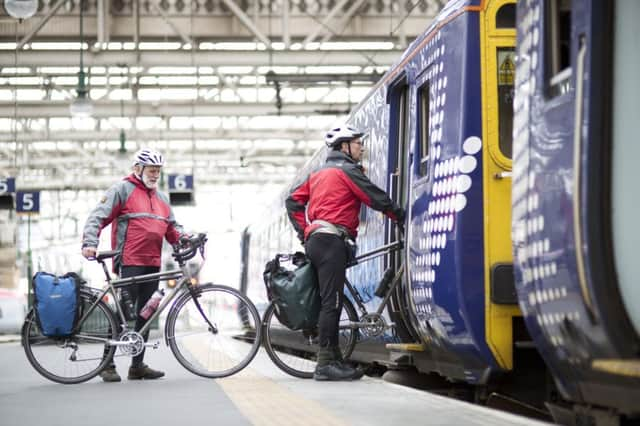Special rail carriages plan to ease bike crowding on Scottish trains


Ministers are developing plans to introduce the segregated space in trains on the West Highland and Far North lines.
The routes to Oban, Mallaig, Kyle of Lochalsh and Thurso are often crammed with passengers travelling with bikes during the summer months.
Advertisement
Hide AdAdvertisement
Hide AdTheir popularity has been boosted by tourism accolades, TV documentaries and links to the Harry Potter films.
However, there was an outcry from cycling groups at plans to change the type of trains on the routes next year, which would reduce the number of bike spaces on board.
ScotRail has already said this is being reconsidered.
The Scottish Government’s Transport Scotland agency said officials were discussing plans with the rail industry and further details would follow.
One option would be to reserve a carriage for cyclists and those with other outdoor sports equipment.
A separate compartment solely for bikes and equipment at one end of the train, like the old guard’s van, may be less attractive because of the longer stops required at stations for loading and unloading.
This option is planned by ScotRail to increase bike space in a refurbished fleet of 40-year-old “High Speed Trains” (HSTs) which are due to be introduced on the Edinburgh/Glasgow to Aberdeen/Inverness routes from May.
However, it has angered campaigners because the compartment will not be accessible at intermediate stations such as Stirling, Perth, Dundee and Aviemore.
David Sidebottom, passenger director of official watchdog Transport Focus, said: “In peak season, getting a seat can be a struggle for some passengers on Highland tourist trains.
Advertisement
Hide AdAdvertisement
Hide Ad“Extra carriages for bikes and other outdoor sports equipment will go a long way to easing the crowding and encouraging additional passengers on these services.”
Dave du Feu, of Lothian cycle campaigners Spokes, said: “It sounds a really innovative and exciting scheme for the rural Highland lines, and for which transport minister Humza Yousaf deserves great credit.”
However, he added: “If there are only three of these carriages, as is rumoured, then clearly many trains will not have them, and so the need for adequate cycle capacity on the normal trains will remain.
“Also, it is important to remember that this is only for the rural lines.
“We have great concerns over cycle capacity on the new HST trains for the main lines from the Central Belt to Inverness and Aberdeen.”
Markus Stitz, founder of cycle tourism developer Bikepacking Scotland, said: “More and better provision for bikes would be a game changer for sustainable tourism in remote regions. While there have been improvements and a certain degree of flexibility by ScotRail, the current provision doesn’t match the needs, especially in peak season.”
He said the six bike spaces on the Glasgow to Oban and Mallaig lines was insufficient at busy times and it was even worse on the Borders Railway.
Stitz said: “Technically, its trains only have two spaces, so if you are a group of more than two, it is pretty much impossible to travel. A family that would like to travel with kids and bikes are very likely forced to take a car.”
Advertisement
Hide AdAdvertisement
Hide AdBy contrast, he said trains in his native Germany could take 20 bikes or more.
A survey by consultants AECOM for the Highlands and Islands Transport Partnership co-ordinating body found trips by cycle tourists made a “reasonable economic contribution” from food and accommodation spending.
It said they were more likely to be male with relatively expensive bikes, staying between seven and ten nights.
AECOM said options to provide more space for bikes included re-designing the bike storage area in the Class 158 trains planned for the line next year, retaining the existing Class 156 trains, and a dedicated bike vehicle.
The consultants also said that there might be a case for introducing a charge for bicycle spaces, as it was common in other countries and would be backed by most rail passengers if guaranteed and quality space was provided.